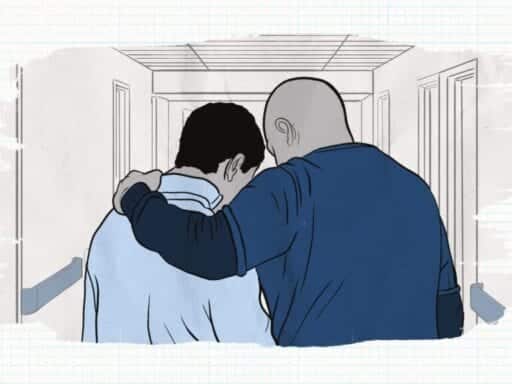Suicide deaths have been rising in recent years. Thoughtful treatment is necessary.
/cdn.vox-cdn.com/uploads/chorus_asset/file/15986155/Vox_The_Highlight_Logo_wide.jpg)
I’ll never forget the first time I cared for a teenager who had made a suicide attempt.
The young man, whom I’ll call Zach, was home from college for winter break. I was a senior medical student completing my clinical rotation in psychiatry. He told me he was having difficulty adjusting to college: He and his roommate weren’t getting along; he missed his brother and parents; and he was beginning to lose touch with friends from high school. Being home, Zach had neither the structure of college, nor the familiar routines he had in high school. I met him after he sustained a serious physical injury when he attempted to end his life.
I wish Zach’s story was a rare occurrence in my career. Unfortunately, over my years in practice, I have been increasingly called on to care for teenagers at risk of suicide, and the stories have only multiplied.
Suicide is the second-leading cause of death (after motor vehicle crashes) in adolescents and young adults, according to Centers for Disease Control and Prevention data, and suicide deaths have been rising for nearly two decades, with an especially concerning spike since 2010. Children’s hospital visits for suicidal thoughts and suicide attempts have doubled since 2008.
/cdn.vox-cdn.com/uploads/chorus_asset/file/19331464/US_teen_suicide.jpg) Javier Zarracina/Vox
Javier Zarracina/VoxAs a pediatrician and child health advocate, my clinical interactions and the statistics inspired me to understand what it’s like for adolescents who seek emergency treatment to prevent suicide. My colleagues and I conducted a research study, published in Hospital Pediatrics, in which we talked with 27 teens who came to the emergency room seeking care for suicidal thoughts or a suicide attempt. Our goal was to understand their experiences in order to improve hospital care for them.
They shared some of the complex triggers for their suicidal crises; they arise from complicated circumstances, and no one event is ever the sole cause. Rather, the teenagers in our study talked about several common themes known to put individuals at risk of suicidal thoughts.
Most have a mental health condition that is treatable with medication and therapy. Teens described how, when their condition wasn’t fully treated, they had intrusive, depressed, or racing, thoughts. Many said they had suicidal thoughts around the difficulty of coping with social pressures, whether from peers, teachers, or other people in their lives. Other teens told us about going through a breakup, experiencing bullying, or having a fight with a family member. For others, the triggers were the illness or loss of a loved one, or far worse, an event in which they were the victim of or a witness to violence.
People often ask me how social media and the internet contribute to teenagers’ risk of suicide. The teens we spoke with rarely discussed them alone as a trigger for their suicidal thoughts. However, for already vulnerable adolescents, technology can provide a forum for more trauma, worsening conflict or isolation. Further, having easy access to information on the internet about how to engage in self-harm can be dangerous for teens with mental health concerns.
When we asked about their thoughts on seeking treatment, overwhelmingly, teenagers said they wanted help for their suicidal thoughts. They wanted to feel better, and they especially appreciated having someone to talk to. (Research supports the idea that trusting relationships with adults can help.)
Sometimes, people who aren’t familiar with caring for teenagers at risk of suicide worry that there is nothing they can do to help if a teen is determined to die. Resoundingly, teenagers expressed just the opposite. They wanted help so that they could stop feeling like they wanted to die. And many of them told us that by coming to the emergency room, they found exactly that — they felt safe. Being in the hospital made them feel less stressed, and some had fewer intrusive thoughts about suicide or death.
Even before they started specific mental health treatments, just being in a supportive environment helped improve their mental health status. Adolescents liked the doctors, nurses, and social workers they met in the hospital, and they felt relieved and well-cared for, knowing that these professionals could support them. They appreciated distracting activities, such as crafts and games, and simple comforts including warm blankets, and tasty meals.
That said, teens also shared some difficult memories and fears about what would come next for them. Many adolescents told us that they had feelings of guilt, remorse, or embarrassment about their suicidal crisis. Others worried about the next steps in their treatment. Most of them would require an inpatient mental health hospitalization once they were stabilized in the emergency room, and they worried about the transition to a new healthcare team.
They also worried about what would face them when they returned home. The structure of the hospital was a respite from their thoughts, and they worried that reimmersion in their daily life would bring their worries and triggers right back. This very real concern highlights how important it is for teens to have a supportive community around them as they recover from a mental health crisis.
For anyone with suicidal thoughts or a suicide attempt, seeking treatment is a life-saving step. The National Suicide Prevention Lifeline (1-800-273-8255) and Crisis Text Line (text HOME to 741741) can offer in-the-moment support to anyone with suicidal thoughts. Local emergency rooms can also offer crisis stabilization and safety measures, and help individuals connect to ongoing mental health care. For some people, this might involve a short stay in an inpatient mental health unit, followed by ongoing treatment with a mental health professional. Others might begin with outpatient services. Regardless of the exact treatment path, support from friends, family, and community members can improve an individual’s experience and help them on their journey towards feeling better.
Adolescents do recover from their suicidal thoughts, and most go on to lead happy and productive lives. With time, our team diagnosed Zach’s mental health condition, and his supportive family, daily medication, and ongoing mental health care helped turn his trajectory around. Though individuals who have experienced a suicidal crisis are at higher risk of experiencing another one, for most teens, getting treatment for a suicidal crisis is an opportunity to uncover emotional challenges and triggers and take steps on the road toward feeling better.
Stephanie Doupnik is a pediatrician at the Children’s Hospital of Philadelphia, a researcher at the hospital’s PolicyLab and Center for Pediatric Clinical Effectiveness, and an assistant professor of pediatrics at the University of Pennsylvania.
Author: Stephanie Doupnik
Read More



